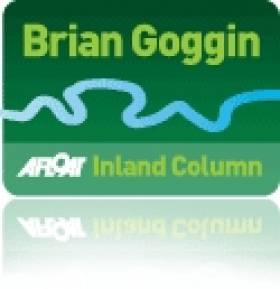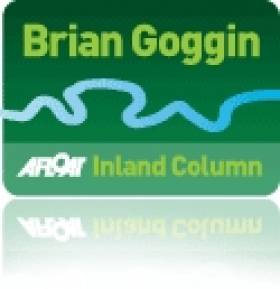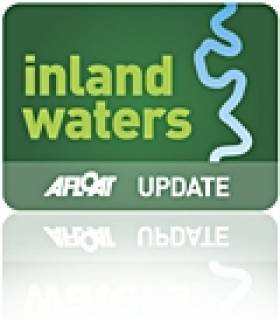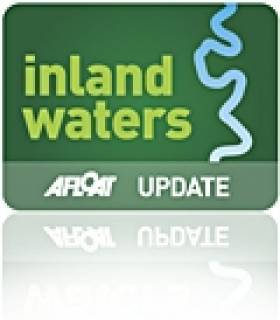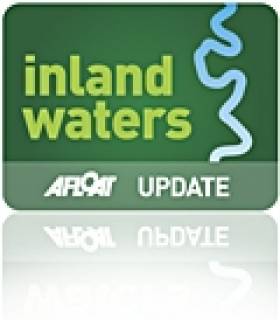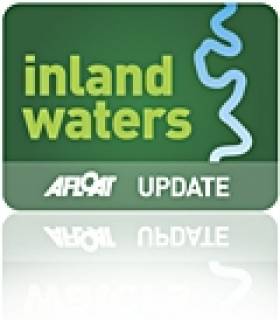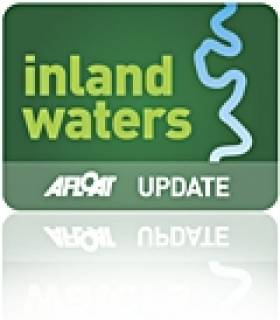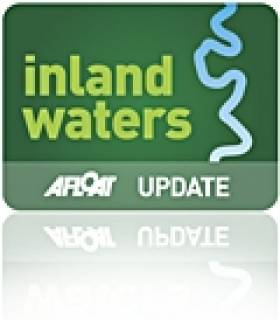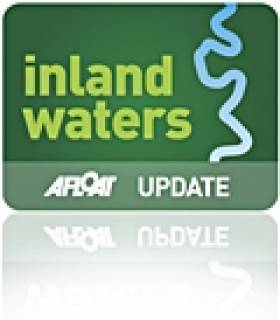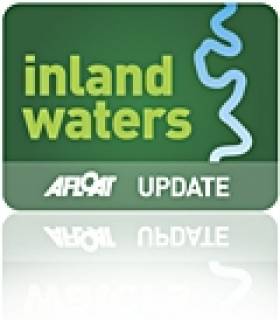Displaying items by tag: Waterways Ireland
Inland Waterways Column: After The Deluge
I started off this column in the last issue by talking about the influence of increased rainfall on inland waterways infrastructure and its users. I wasn't expecting a record-breaking deluge, but that's what we got in November.
I live near the old Limerick Navigation, which was bypassed and abandoned when Ardnacrusha was built. Since then, the old route gets the first 10 cubic metres of water per second and Ardnacrusha gets the next 400. If there is anything left over, it's sent down our way.And during the floods, there was a lot left over. I had always wondered what the water levels on the old navigation were like; these two photos, taken on the Park Canal in Limerick, tell the story.
But while my antiquarian interest was being gratified, people upstream were being flooded out of their homes and businesses. On Lough Derg, owners moved boats; the Killaloe Coast Guard moved boats; marina staff moved boats. And water levels continued to rise.
Waterways Ireland issued regular updates. An embankment slippage closed the Lough Allen Canal; Albert Lock and the Jamestown Canal had to be closed to navigation. And then the Clarendon, Roosky, Athlone and Pollboy locks had to be closed, and it was not possible to pass through Lock 36 between the Shannon and the Grand Canal. Further east, the Grand Canal near Sallins was affected by flood remedial works.
On the Erne, spilling of excess water from Ballyshannon dam meant faster currents in narrow river sections. Many fixed jetties were under water. The consequent damage required closure of 13 jetties on Lower Lough Erne and eight on the Upper Lough. Several navigation markers were damaged, as were pump-out holding tanks at Galloon and Carrybridge.
On Lough Neagh, the canal entrance to the Bann at Toomebridge was heavily silted; dredging had to await improved weather.Sarsfield Lock in Limerick had to be closed for maintenance (although the Abbey River was impassable anyway). There is no telling how much damage the floods did: the photo shows Derg Marina at Killaloe, where staff had worked valiantly to look after the boats, but theirs was not the only marina to suffer. Incidentally, the planning application for a major development at the site has been withdrawn.
Those who worked to save lives, structures, houses, businesses and, yes, boats during the floods deserve thanks: that includes staff of the Coast Guard, WI and ESB, local authorities and marinas, as well as many boaters and doubtless lots of other people. But some younger folk had fun during the floods: here are kayakers in Limerick at the Curraghgour Falls standing wave.
WI warnings welcomeSome years ago, I was told that Waterways Ireland could not advise boaters not to go boating. That reluctance has certainly been overcome, and rightly so. WI didn't just inform people about the lock closures; it issued warnings throughout the period, progressing from reminders ...
Masters and owners are reminded that, following periods of prolonged rainfall, high flow rates, increased current speeds and water turbulence especially in the vicinity of bridges, weirs, locks, flood gates and other infrastructure will be hazardous to craft and persons on or near the navigation. Air draft at bridges will be reduced as water levels rise also.
... through information ...
Waterways Ireland wishes to advise Masters and Owners that due to the continuing flood conditions that aids to navigation such as buoys, perches and beacons may be totally submerged or have carried away to the extent that the navigable channels are no longer discernable, making all navigation hazardous.
... to sensible advice:
Waterways Ireland advises against navigating at present due to high water levels and the associated difficulties in manoeuvring vessels in the high flow rates. It even issued advice about the icy conditions that succeeded the floods.
What is needed now is a way of getting WI advice to people who are actually on the river: perhaps an electronic equivalent of the British Environment Agency's Strong Stream warning boards.
Planned winter work
The water levels have gone down, the days are lengthening and the work goes on. This listing does not take account of the repairs required after the floods.
Erne
On Upper Lough Erne, Waterways Ireland is improving the mooring jetties, slipways and car-parks at Corradillar and Derryadd and the jetties at Naan Island.
Shannon
On the Shannon, Clarendon Lock at Knockvicar, at the entrance to Lough Key, was to have its lockhouse refurbished. Roosky Bridge was to be closed to boats for maintenance and refurbishment.
Major work is under way at Killaloe on Lough Derg, with 250m of new floating moorings being positioned outside the canal wall above the bridge. The wall itself is being repaired and will have a 450m walkway along it. Flow control gates, with a pedestrian bridge providing access to the walkway, will be installed at the northern end of the canal to protect the wall and banks. To allow the wall to be repaired, boats (including sunken boats) will have to be removed from the canal.
Dublin
In Dublin, the walls of Grand Canal Dock (Ringsend Basin) are being repaired at Hanover Quay (north side) and Charlotte Quay (south side). That requires dredging of (probably contaminated) material, which can't be sent to landfill in Ireland, underwater cleaning of the walls and repair with 100mm of micro-concrete coating.
The Grand Canal is being dredged between Locks 1 and 5 and the Royal between Locks 1 and 6, paid for by the National Development Plan. Sediment and rubbish will be transported to 'licensed disposal facilities'. This dredging will make it easier for boats to get through Dublin once the Royal Canal is reopened. Whenever that is...
Grand Canal
On the Grand Canal, a leak had to be repaired between Locks 29 (Ballycowan) and 30 (Rahan) and bank repairs were required between Henry Bridge and Ponsonby Bridge (Locks 13 to 14). Down the Barrow Line, the stretch between Locks 21 (Ballyteague) and 22 (Glenaree) was to be dredged.
Shannon-Erne Waterway
On the Shannon-Erne Waterway, Ardrum Lock was closed for maintenance and Corraquill to have a floating landing jetty installed. After the floods, the closure of Ballyconnell and Tirmactiernan Locks was announced.
Waterways Ireland has given notice that, from 1 March 2010, it intends to implement the provisions of SI No 24/1988: Canals Act, 1986 Bye Law (25 ,1 (d)) on all hard-edged moorings in the Shannon Harbour area (between 35th Lock and Griffith Bridge). The effect will be to ban mooring at the same place (or within 500 metres thereof) for more than five days without a permit. The intent is that the improved facilities will be kept free for visiting boats. WI has said that vessels should not double or triple park so that the centre channel can be kept clear. Offending vessels and those without permits will be moved.
Waterways People
The Past President of the IWAI, Brian Cassells, has been awarded an OBE for services to IWAI. A passionate advocate of the restoration of the Ulster Canal, Brian is a historian of the waterways and has recently published By the Shores of Lough Neagh.
Victor Hamill, who was Chairman of the River Bann and Lough Neagh association, died recently in Coleraine. He was Secretary of Bann Rowing Club and was also active in Coleraine Harbour Commissioners, the Lough Neagh Advisory Committee and the RNLI. He died after suffering a heart attack while rowing on the Bann with his brother, Norman.
Dick Fletcher, founder of the Galley cruising restaurants at New Ross, died recently. Having started with the M V Ross, Dick later bought the St Ciaran and the St Brendan, which CIE had used on the Shannon. As well as keeping these historic vessels going, he also provided many people with their first sight of the glorious scenery on the tidal Nore and Barrow.
A rub of the greenIn its report on the grounding of an Emerald Star hire-cruiser on Lough Derg in 2006, the Marine Casualty Investigation Board said:
Waterways Ireland should, in consultation with the Maritime Safety Directorate, establish a buoyage system for inland waterways, which is internationally recognized by all users of the waterways both national and foreign.
Waterways Ireland has now announced that the Shannon system will change its starboardhand marks from black to green. The change is to be phased in, with the stretch from Portumna Bridge to Meelick Lock the first to be changed.
No announcement has been made about the implications for the Erne system.
New workboats
Waterways Ireland is seeking tenders for several new workboats. One is for a 12m low-wash steel boat to be used on the Shannon-Erne Waterway. It is to have a single box-cooled diesel-electric hybrid engine, a bowthruster and an onboard generator. It must also have a low wheelhouse, welfare and toilet facilities and a deck crane.
WI also wants a weed cutter/harvester for the canals and two more weed-cutting boats for use on 'various canals and waterways'. These two are to have heated weatherproof cabs, keel cooled engine and hydraulic systems and twin trailing knives.
Published in Afloat February 2010
Inland Waterways Column: Smiling Through The Rain
We spent the first fortnight in July travelling up the Shannon and back. It rained on most days, but there were compensations
We passed down through Shannonbridge just a week before its chimneys were demolished. I was sorry to lose them. They could be seen from a long way up- and down-stream and from the River Suck. And they were emblematic of the Irish midlands and of the important role of turf in the provision of Irish energy. The turf trade was at least as important to the Irish waterways as the coal trade was to the British, and some of the Shannon steamers even used turf as fuel. I'm glad, therefore, I took a photo before the demolition.Carrickcraft to the rescue
Moored in Dromod on a miserably wet and windy evening, we saw a Carrickcraft cruiser aground on a shoal. It appeared to be well inside the relevant marker, although visibility was so poor that the driver might have been forgiven. The photo is not very clear, but it does show what conditions were like.
The speed of Carrickcraft's response was impressive. Even though it was a Saturday, presumably their busiest day with new hirers going out, they launched a dory at Dromod within the hour and were attempting to tow the cruiser off. The dory didn't have the weight, though, so the Carrickcraft crew took out a second cruiser, and that did the job. Within half an hour of launching the dory, the crew had the grounded cruiser safely moored within the harbour. Which was just as well: at 2am the barometer was showing 988. I'm sure that rescuing grounded boats is all part of the day's work for Carrickcraft crews, but nonetheless it was great to see that kind of efficiency in action.
Incidentally, on Lough Derg an Emerald Star hire-boat rescued a private boat that had a fuel problem on a windy day: the hirer towed the other boat into the Castle Harbour at Portumna.
WI moves on Shannon
Waterways Ireland's continuing investment in the Shannon was shown in the arrival of its new workboat for the North Shannon, the Inis Cealtra. Built in Killybegs to a new design, it was sailed down the coast, in 30 hours non-stop, and up the Shannon Estuary through Limerick: its dimensions (22m x 5.6m x 0.98m) had been set so that it could get through Ardnacrusha.
Inis Cealtra has a pusher bow and four ballast tanks to allow trim to be adjusted. The air draught is low enough to cater for all but extreme high water levels. Twin spud-legs are carried on the reinforced load-bearing deck.
Power is from twin Caterpillar C3056TA engines developing 185hp at 2,100rpm; conventional shafts and propellers provide a cruising speed of 7 knots and a bollard pull of 3.5 tons. There is a hydraulic bow-thruster. The fuel tanks hold 7,400 litres.
The boat has an 11m reach Guerra deck crane with Kranskan marine crane safety indicator, a Caterpillar 30 kVA generator and a 270-litre air compressor, which powers air tools in the workshop. The boat has a toilet and shower; the deckhouse has a kitchen and dining room as well as the wheelhouse.
Rental traffic continues to slide
My impression, as we pottered up and down the Shannon, was that traffic was down, and that hire-boat traffic was down even more than private-boat traffic. The Waterways Ireland traffic figures for the Shannon, to the end of June, support that view.
It has to be pointed out, of course, that WI can record only those boats that pass through locks and fixed bridges: boats that spend all their time on lakes, for instance, may never be recorded. However, as the same limitation applies every year, the figures can show the trends, and they are downward. Here are the totals (private plus hire) for the first six months of each year from 2002 through 2009:
I haven't got the breakdown between private and hired for the early years, but from 2006 onwards the hire-boat proportion has declined significantly from 69% (2006) through 67% (2007) and 64% (2008) to only 57% (2009). Again, these figures cover only the first six months of the year.Rebranding the waterways
The traffic figures show that cruising — whether on private or on hired boats — is declining in importance on the Shannon. The numbers of small fast boats and jetskis and increasing; there has so far been little formal provision for them, but some owners of such boats have looked after themselves.
The problem is that some of these boaters are both new to the waterways and seemingly unaware of the rules. We saw the results when a four-wheel-drive vehicle launched a speedboat at the slip at Portrunny. The boat (which was not any of those shown in the photo) was driven into the harbour and a waterskier sat on the pontoons; the boat started towing, at high speed, from there, creating a large wash and a danger to anyone else who might have been moving in the harbour.
There are other new categories of users, notably the owners of motor-homes: WI harbours provide them with the perfect mix of cheap sites with good facilities (showers and toilets) and even (if they like boats) interesting things to look at.
With other groups, though, Waterways Ireland is both organising new users and exerting its authority over old ones. I was surprised to find an angling dory bearing a Shannon Navigation registration number: the size of its engine meant that it should be registered, but I had not realised that anglers were complying.
In attracting new users, WI's sponsorship of the 'Discover' days in Athlone and Carrick-on-Shannon is particularly commendable; perhaps we'll get one in O'Briensbridge next year. But the big event on the Shannon seemed to be the Athlone Triathlon, which involves swimming, running and cycling races. It would be nice to see an all-water triathlon developed, perhaps involving rowing, sailing and swimming or, in Limerick (where different propulsion methods were used over the falls), poling, paddling and swimming.
Waterways Ireland planned work
I am delighted to see that Waterways Ireland has issued a notice calling for tenders for dredging the Grand Canal Circular Line in Dublin. The work will 'remove all excess bed material above original design bed level,' which suggests that Waterways Ireland is seriously planning to encourage more boat traffic through Dublin. It may even be that WI has been convinced of the merits of promoting the 'Irish Ring': the round trip on the Grand, the Royal and the Shannon from Clondra to Shannon Harbour.
I note that the tender calls for 'the transportation of material from site to an agreed traffic management plan, with the full compliance Dublin City Council requirements'. No doubt that will be done by water, thus avoiding all traffic problems.
Incidentally, while I'm talking about the Grand Canal in Dublin, I must mention the parking of the weedboats. WI keeps them under towpathless bridges to keep them safe from the attentions of the less enlightened of the citizenry. That is quite understandable. But when a boat is known to be on its way, the weedboats should be shifted in advance: otherwise there can be a delay to the passage through some of the less salubrious areas.
Anyway, back to planned works. WI is also seeking tenders for repairs to the quay at Graiguenamanagh, demolishing part of the old wall and replacing it with a reinforced concrete wall, faced with 'selected ashlar masonry' and re-pointed as directed.
Finally, WI is considering extending navigation to Lough Oughter, upstream of Belturbet on the Erne. There is to be a Lough Oughter Navigation Plan, with many laudable aims, which will be 'implemented with medium and long-term goals for the extension of the inland waterway network to include the development of the Lough Oughter Complex. The Plan, its objectives and its goals will be re-evaluated in 2013.'
In other words, there is no immediate prospect of the extension of navigation, but WI has drawn up a Draft Consultation Scoping Report for the Strategic Environmental Assessment for the Lough Oughter Navigation Plan. It can be downloaded from the WI website www.waterwaysireland.org (see 'Lough Oughter' under 'Navigation Information') and WI is seeking comments.
Published in Afloat September/October 2009
Inter-County Sailing Championship Set for Grand Canal Dock
Sailors from around Ireland are invited to submit a team comprising a crew of up to 5 people capable of handling a 27ft keel boat, to include at least 1 female, to represent counties in what organisers say will be the battle of the sailing tribes and colours of Ireland.
Racing in 1720 sportsboats will comprise a series of sprint flights (heats) of approximately 20 minutes leading to the semi-finals and finals to decide the winner.
With boats constantly in close quarters and potential crash situations both with each other and the solid quay walls, this event promises to be a testing and thrilling experience for the sailors crewing onboard and a highly entertaining spectacle with viewing areas for spectators on the quay walls and the Grand Canal Square.
The championship will take place on Sunday 26th June from 0900hrs – 1600hrs.
A fleet of one design boats 27ft in length is being provided so teams can compete on a level playing field. Ownership of a boat is not necessary, and sailors and clubs wishing to enter a team to represent their county should contact Waterways Racing below.
The Grand Canal Dock is part of Ireland's inland waterways system and comprises 44 acres of non-tidal freshwater in Dublin's Docklands. It has it's own marina, Waterways Interpretive Centre, Watersports Centre and is surround by a multitude of bars and restaurants and is overlooked by the recently opened Grand Canal Theatre.
This event will act as a centre piece in the Docklands Summer Festival 2011 which is being organised by the Docklands Business Forum (www.docklandsbusinessforum.ie) and the Dublin Docklands Development Authority (DDDA, www.ddda.ie) to run from Friday 24th – Sunday 26th June.
The event is sponsored by Waterways Ireland, an all island body set up to manage & promote all of Ireland's waterways. Commenting on their sponsorship of the event "We are delighted to be involved in this sailing championship which invites participation from the whole island of Ireland in keeping with our own remit as an inter-governmental agency. We are looking forward to welcoming teams, supporters and the general public to this historic dock in Dublin for the inaugural Waterways Ireland Inter-Counties Sailing Championship" Martin Dennany, Marketing Director, Waterways Ireland.
More here.
Waterways Ireland Issues Notice to Remove Abandoned Craft
Waterways Ireland intends to remove sunken and abandoned vessels from the Grand Canal/Barrow Navigation on inland waterways. The notice indicates nine boats listed for removal. The biggest craft is a 10-metre long steel cruiser, the Celtic Mist, located on the North bank of the west 35th lock. The full list of boats is below.
Notice of Intent to Remove Craft under Canals Act, 1986 Bye-Laws, 1988
Waterways Ireland wishes to advise all masters and users that notice is now given of its intention to remove sunken and abandoned vessels from the Grand Canal/Barrow Navigation in accordance with the Canals Act, 1986 (Bye-Laws), 1988.
The vessels have been sunk for a considerable time and all efforts to locate owners have failed.
Waterways Ireland now intend to remove the craft and dispose of them as appropriate, unsound wooden craft will go to land fill and steel/fibre glass craft will be disposed of by public tender in the near future ( notices will be published).
|
SUNKEN/ABANDONED CRAFT APRIL 2011 |
|||
|
VESSEL NAME |
TYPE |
LOCATION |
LENGTH |
|
HEYDAY (2711) |
Small GRP Cruiser |
South Bank East of Griffith Bridge |
7m |
|
AH KATHLEEN (8026) |
Small Barge/Cruiser |
South Bank East of Griffith Bridge |
7m |
|
BEAL NA BLATH |
Wooden Cabin Cruiser |
South Bank East of Griffith Bridge |
7m |
|
No Name |
Wooden Cabin Cruiser (Green) |
South Bank East of Griffith Bridge |
7m |
|
PALOMA (2136) |
Wooden yacht (White) |
South Bank East of Griffith Bridge |
7m |
|
MAXIR II (6050) |
Cabin Cruiser |
South Bank East of Griffith Bridge |
7m |
|
WAVE DANCER |
Speed Boat |
Area of Transit Shed – on hard |
5m |
|
CELTIC MIST (3619@) |
Steel Hulled Cruiser |
North Bank – West 35th Lock |
10m |
|
NO NAME (7441) |
Small day boat with cabin |
North Bank – West 35th Lock |
5m |
Celebrating the Three Sisters Navigation
This year we celebrate the 220th anniversary of the opening of the Barrow Navigation. This linked the Grand Canal with the rivers Barrow, Nore and Suir, and opened up a large area of the hinterland to the great ports of Dublin and Waterford. When the canals closed to commercial traffic in the 1960s it was feared that all use of the navigation would soon cease. Indeed, non-commercial traffic did become very light, but now, following excellent remedial works by Waterways Ireland we welcome a new era for this navigation, one which will bring new life and vitality to the waterway in the towns and villages along the system.
A hundred years ago, 1,200 boatmen were engaged in the business of transporting cargo, connecting people in inland towns with those in Irish ports, and in turn linking them with the great sea ports of the world. Today, many of their descendants live along our inland navigations.
Three of these great canal boats, numbers 72M, 68M and 107B, escorted by a flotilla of other HBA boats will, over the next few months, travel the entirety of the Navigation including Carlow, Waterford, Carrick on Suir, Inistioge and all points in between. The crews are anxious to meet with those whose families had connections with the commercial trade along the waterway, and perhaps even re-unite some long retired boatmen with their old boat.
The following are the expected arrival dates in various locations over the next few weeks:
° Carlow April 9th from 14.00
° Leighlinbridge April 16th from 14.00
° Bagenalstown April 24th from 13.00
Navigable Channel in Shannon Harbour Now Open
Inland waterways Marine Notice No. 27 of 2011 Waterways Ireland advises masters and users that the navigable channel in Shannon Harbour on the Grand Canal is now open. The new house boat facility remains closed to the public as construction work continues.
Click this link for the latest boating news on Ireland's Inland Waterways
Inter-Agency Response to Lough Erne Weed Invasion
A new inland waterways inter-agency response to the rising levels of invasive weed growth on Lough Erne has been launched.
The Lough Erne Invasive Species Group (LEISG) brings together Fermanagh District Council, the Northern Ireland Environment Agency (NIEA), Waterways Ireland, the UK's Departments of Culture, Arts and Leisure, and Agriculture and Rural Development, among others, to tackle the threat posed by the invasive Nuttall's Pondweed.
LEISG says the weed has survived the winter "in significant quantities", and the potential for its rapid spread poses a serious concern for tourism and leisure on Co Fermanagh.
The group has recommended harvesting and weed-cutting as the most effective method to control Nuttall's Pondweed where it may interfere with main channels and access to public amenities.
Management of water levels has also been identified as playing a role in future control of the weed.
Anyone wishing to assist in weed-cutting must contract the NIEA through www.nidirect.gov.uk for permission. More information on invasive species is available at www.invasivespeciesireland.com.
Waterways Ireland to Apply 'Five Day Rule' This Month
Waterways Ireland has reminded all Masters and users of the Grand Canal on Ireland's inland waterways that it intends to move vessels double or tripled berthed on the Grand Canal and Shannon Harbour that contravene the five day rule.
The enforcement of SI No. 24/1988: Canals Act, 1986 Bye Law (25 ,1 (d)) applies to all hard edged moorings in the harbour area with effect from 17th March 2011.
At Tullamore this area is deemed to be between White Hall Bridge and Waterways Ireland Offices.
At Shannon Harbour The area is deemed to be between 35th Lock Eastwards to Griffith Bridge.This enforcement will clear the channel for navigation and facilitate the movement of both visiting and Shannon Harbour based vessels. Alternative berthing is available upstream of Griffith Bridge. Boats should only be moored singly on either side of the canal to permit the safe passage of craft. Bye Law (25, 1 (b) states that sufficient space must remain so that two vessels can pass at the same time. Berthage is also available on the North Bank between 35th and 36th Lock.
Vessels in contravention of this bye-law will be moved East or West of the area as space becomes available. Non permitted vessels will also be moved.
This enforcement will facilitate the movement of visiting vessels. Vessels should only moor directly onto quay walls and not double and triple berth. Alternative berthing is available on the main line.
Vessels in contravention of this bye-law will be moved onto the main line. Non permitted vessels will also be moved.
Owners and Masters of vessels are requested to assist in this enforcement in order to open the area to more vessels and facilitate the proper use of the harbour.
End of Winter Mooring Period in Public Harbours
20 Metre Weir Boom Installed at Knockvicar
Installing the 20m boom was initiated with assembly of the boom off-site in Rooskey. In early December, the drilling for the piles was facilitated by floating a piling rig to the site on pontoons. Piles are required to hold the Weir Boom in place. The boom was then floated to the site and secured in place. The works cost approximately €55,000.
Installation of the boom improves the amenity at Knockvicar in addition to lock gate replacement and upgraded lockhouse facilities which have been completed by Waterways Ireland in recent years.
The Weir Boom is a preventative measure installed by Waterways Ireland to protect boaters and their craft from being drawn over the weir. Space has been left to allow for the passage of canoeists. There will be no environmental impacts on fish or other wildlife from the installation or operation of the Weir Boom.


























